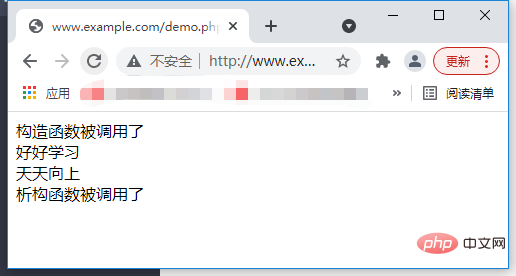
In the previous article, I brought you "How to instantiate objects and access object members in PHP? ", which introduces in detail how to instantiate objects and access object members. In this article, we will take a look at the constructors and destructors in PHP. I hope it will be helpful to everyone!

The constructor in a PHP class is also called a constructor. When an object is instantiated using the new keyword, it can be automatically called when the object is created. It is the a special function. The corresponding function is the destructor. The role of the destructor is exactly the opposite of the constructor. The destructor can perform operations before the object is destroyed. Then let's take a look at these two functions together.
<strong><span style="font-size: 20px;">__construct()</span></strong>:Constructor/method
In PHP classes, we use __construct() as the constructor of the class. The constructor is the first function that is automatically called in the class when the object is created, and can only exist in a class. A constructor, and it should be noted that if there are parameters in the constructor, then the corresponding parameters also need to be passed in for instantiation.
The syntax format created by the constructor is as follows:
public function __construct(参数列表){
... ...
}It should be noted that the parameter list is optional and can be omitted when not needed. construct is preceded by two underscores __.
The examples are as follows:
<?php
class study{
public $study1, $study2, $study3,$study4;
public function __construct($str1, $str2, $str3,$str4){
$this -> study1 = $str1;
$this -> study2 = $str2;
$this -> study3 = $str3;
$this -> study4 = $str4;
$this -> demo();
}
public function demo(){
echo $this -> study1.'<br>';
echo $this -> study2.'<br>';
echo $this -> study3.'<br>';
echo $this -> study4.'<br>';
}
}
$object = new study('好好学习','天天向上','福如东海','寿比南山');
?>$this in the example represents the currently called object. Output result:

From the above results, we pass the __construct() constructor to call the object created in the class.
<strong><span style="max-width:90%">__destruct()</span></strong>: Destructor/Method
Just mentioned__construct()The constructor function will be called when the object is created. The corresponding function is the destructor. The destructor function is opposite to the constructor function. The destructor function It will only be automatically called when the object is deleted from the memory. There is a garbage collection mechanism in PHP. When the object cannot be accessed, the garbage collection mechanism will be automatically started. The destructor is called before the garbage collection object.
__destruct()The syntax format of the function is as follows:
public function __destruct(){
... ...
}It should be noted that, similar to the constructor, destruct is also preceded by two underscores __;The difference is that the destructor cannot take any parameters.
The example is as follows:
<?php
class Website{
public $study1, $study2;
public function __construct(){
echo '构造函数被调用了<br>';
}
public function __destruct(){
echo '析构函数被调用了<br>';
}
}
$object = new Website();
echo '好好学习<br>';
echo '天天向上<br>';
?>Output result:

It can be seen from the above example that the constructor and The destructor is called at different times. The constructor is automatically called when the object is created, and the destructor is called before the object is collected by the garbage collector.
<strong><span style="max-width:90%">$this</span></strong>:The current object
is in PHP In object programming, after the object is created, in each member method of the object, there will be a special object reference "$this", which is connected with the connector -> Used jointly, specifically to complete access between internal members of an object. An example is as follows:
$this -> 成员属性; $this -> 成员方法(参数列表);
When we access a member attribute in a class, we only need to follow the attribute name. There is no need to add the $ sign. $this can only be used in objects. Without an object, there is no $this.
The example is as follows:
<?php
class Website{
public $name;
public function __construct($name){
$this -> name = $name;
$this -> name();
}
public function name(){
echo $this -> name;
}
}
$object = new Website('好好学习');
?>Output result:

If you are interested, you can click "PHP Video tutorial》Learn more about PHP knowledge.
The above is the detailed content of Let you distinguish the constructor and destructor in a class. For more information, please follow other related articles on the PHP Chinese website!